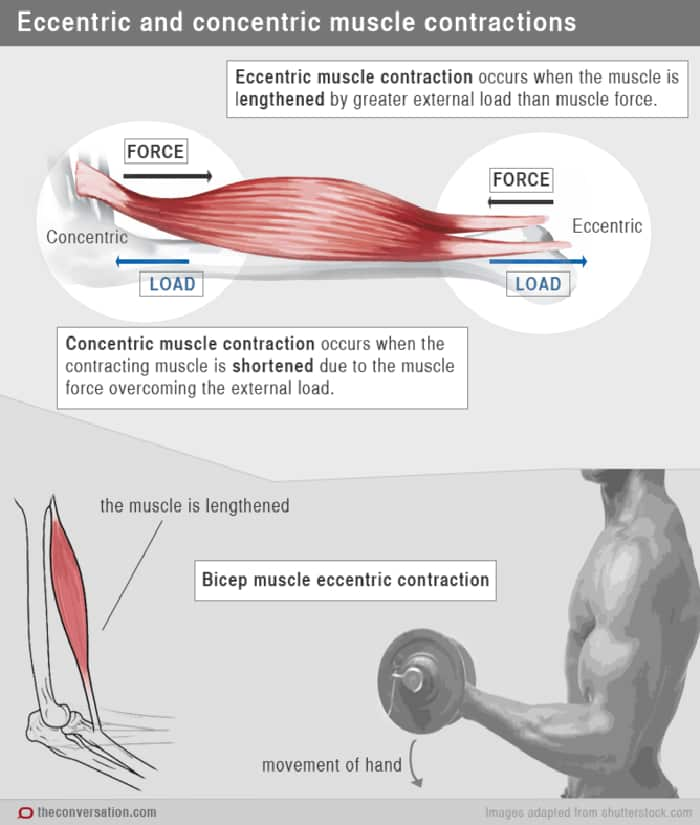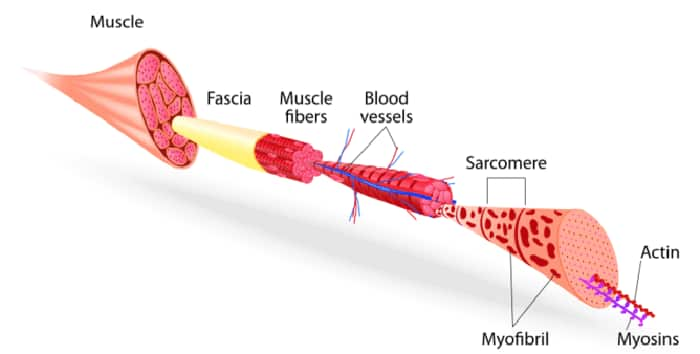The exercise that induces DOMS consists of eccentric (lengthening) muscle contractions in which contracting muscles are lengthened. Walking down a set of stairs or slope, where front thigh muscles are lengthened when supporting the body weight, is one example of eccentric exercise.
Another is using weights, such as a dumbbells. When lowering a heavy object slowly from an elbow flexed to an extended position, the muscles to flex the elbow joint perform eccentric exercise, since the external load (dumbbell) is greater than the force generated by the muscle. Exercise consisting of mainly concentric (shortening) contractions, where muscles contract and are shortened, such as walking up stairs and lifting a dumbbell, does not induce DOMS at all.
Exercise consisting of mainly concentric (shortening) contractions, where muscles contract and are shortened, such as walking up stairs and lifting a dumbbell, does not induce DOMS at all.

Source: The Conversation
DOMS is technically considered an indicator of “muscle damage”, as muscle function decreases and, in some cases, muscle-specific proteins increase in the blood, indicating plasma membrane damage. But it appears that very few muscle fibres are actually injured or destroyed (less than 1 per cent of total muscle fibres).
Interestingly, other structures such as fascia (the sheath of tissue surrounding the muscle) and connective tissue within the muscle appear to be more affected by eccentric contractions. A study my colleagues and I recently published tested the hypothesis that fascia would become more sensitive than muscle when DOMS is induced. We probed the muscles of volunteer eccentric exercisers with an acupuncture needle designed to introduce a steadily increasing electrical current from its tip, until they reported muscle pain.
A study my colleagues and I recently published tested the hypothesis that fascia would become more sensitive than muscle when DOMS is induced. We probed the muscles of volunteer eccentric exercisers with an acupuncture needle designed to introduce a steadily increasing electrical current from its tip, until they reported muscle pain.

Source: The Conversation
The results showed that DOMS was associated with the increased sensitivity of muscle fascia to the stimulus, suggesting the source of pain is fascia (connective tissue) rather than the muscle fibres themselves.
We still don’t know how eccentric contractions affect connective tissue surrounding muscle fibres. It’s possible they have different levels of elasticity. So, as the contracting muscle is stretched, a shear force may develop between muscle fibres and their surrounding connective tissue. This may damage the structure and cause inflammation.
It’s still a mystery why there’s a delay between the exercise and muscle soreness. Researchers speculate that it’s due to the time it takes for inflammation to develop after the micro-injury.
It doesn’t appear that DOMS is a warning sign not to move the affected muscles, since moving the muscles ameliorates the pain and does not hamper the recovery. It may be that DOMS is a simple message from the body that the muscle lacked a good stimulus for a while, which it received.
But is it necessary for developing bigger and stronger muscles?
There’s no scientific evidence to support the theory of “no pain no gain”. Research shows eccentric exercise training produces greater increases in muscle strength and size when compared with concentric exercise training, but this is not necessarily associated with “muscle damage.”
Don’t be afraid of DOMS, although it could bother you for several days after exercise. DOMS reduces when the same eccentric exercise is repeated. If the intensity and volume of eccentric exercise are gradually increased, you can minimise DOMS.
In the meantime, think of DOMS as a useful signal from your body. Ken Nosaka, Professor of Exercise and Sports Science, Edith Cowan University
Ken Nosaka, Professor of Exercise and Sports Science, Edith Cowan University
Share
Watch the FIFA World Cup 2026™, Tour de France, Tour de France Femmes, Giro d’Italia, Vuelta a España, Dakar Rally, World Athletics / ISU Championships (and more) via SBS On Demand – your free live streaming and catch-up service. Read more about Sport
Have a story or comment? Contact Us

